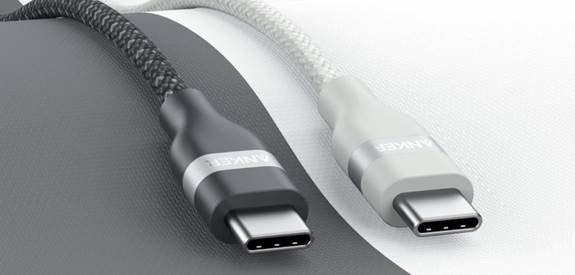Many
devices now come with USB-C charging ports, offering increased convenience and
faster charging speeds. However, not all USB-C cables are created equal. This
brings up an important question: “Are all USB-C cables safe for high-power
charging?” The short answer is no. Choosing the right usb c cable is crucial
to ensure the safety and longevity of both the cable and your device.
Poor-quality cables can result in damage, overheating, or inefficient charging.
This blog aims to guide you through the ins and outs of USB-C cables, their
specifications, and how to choose the right one for high-power charging.

Understanding USB-C Cable Specifications
Power Delivery (PD) Standards and Wattage Ratings
Power
Delivery (PD) is key when discussing USB-C cables. PD standards facilitate
high-power charging by dynamically adjusting power levels. USB-C cables
adhering to PD standards can support up to 100W of power, which is significant
for charging high-demand devices like laptops. Each PD-certified cable will
have specific wattage ratings, crucial for assessing whether a cable can handle
high-power charging tasks.
Data Transfer Speeds
Data
transfer speed is a key factor to consider when choosing a USB-C cable. These
cables support various standards, including USB 3.2 and Thunderbolt 4, each
offering different performance levels. Higher standards typically provide
faster data rates—USB 3.2 supports up to 20 Gbps, while Thunderbolt 4 reaches
up to 40 Gbps. Knowing the speed capabilities of your cable is especially
useful for tasks like transferring large files, editing high-resolution video,
or backing up data quickly. Selecting a cable that matches your device’s
capabilities can significantly boost productivity and prevent slow transfer
bottlenecks. Always check the cable's specs to ensure it meets the demands of
your workflow.
Risks of Using Incompatible or Low-Quality Cables
Potential Damage to Devices
Using
incompatible or low-quality cables can have severe consequences. Poorly
constructed cables lack the necessary insulation and structural integrity,
making them prone to internal failures. These failures can lead to inconsistent
power delivery, which may damage device batteries over time or cause immediate
malfunctions. Low-quality materials can degrade, affecting both charging
efficiency and safety.
Safety Hazards and Overheating
Cheap
or counterfeit cables also pose significant safety hazards. They can overheat,
potentially causing burns, fires, or other dangerous situations. Internal
components might not be designed to handle higher currents, leading to
overheating and short circuits. Such cables lack the rigorous safety testing
associated with certified products, making them unreliable for high-power
charging and risky for users.
How to Identify Safe and Certified USB-C Cables
Recognizing USB-IF Certification and Compliance Marks
To
ensure safety, look for USB-IF (USB Implementers Forum) certification on the
packaging. This certification indicates that the cable meets established
standards for quality and safety. USB-IF Certified cables undergo stringent
testing procedures. Check for compliance marks, like the official USB trident
logo, on the product, which suggests the cable’s authenticity and capability.
Trusted Brands and Recommended Products
Trusted
brands provide an additional layer of security. Companies like Anker are known
for producing reliable USB-C cables. These brands follow industry standards,
making their products a safer choice. When in doubt, consulting reviews and
recommendations from reputable sources ensures that you’re selecting a quality
product that won’t harm your device or pose safety hazards.
Recommended High-Quality USB-C Cables
Anker
has built a strong reputation in the world of USB-C cables, offering reliable
solutions trusted by tech enthusiasts and professionals alike. Known for their
durability and strict compliance with USB Power Delivery (PD) standards, Anker
cables are designed to support fast and safe high-power charging. Some models stand out for their reinforced stress points and premium materials, which regulate current flow to
protect both your devices and the cable itself. Whether you're charging a
smartphone, tablet, or laptop, these cables deliver consistent performance.
Choosing an Anker USB-C cable means prioritizing safety, efficiency, and
long-term value—making them an ideal companion for demanding, high-wattage
charging needs across various devices.

Best Practices for High-Power USB-C Charging
Matching Cables with Compatible Chargers and Devices
Proper
pairing of cables with compatible chargers and devices is essential. A
mismatched setup can result in inefficient charging or potential damage. Check
device specifications to ensure that both the charger and the cable can handle
the power requirements. For instance, using a 60W cable with a device that
needs 100W will result in slower charging.
Tips for Safe Charging and Cable Maintenance
Maintaining
your cables is also vital. Regularly inspect for wear and tear, and replace any
damaged cables. Avoid sharp bends and kinks that could degrade cable integrity.
Store cables properly to avoid undue stress on the connectors. Also, avoid
exposing cables to extreme temperatures or liquids. Following these simple
practices ensures that your cables remain functional and safe.
Conclusion
Understanding
the importance of using the right USB-C cable for high-power charging cannot be
overstated. Not all cables are created equal, and using subpar options can lead
to damage and safety hazards. By focusing on certified, high-quality cables and
adhering to best charging practices, you can ensure both the longevity of your
devices and a safer charging experience.
